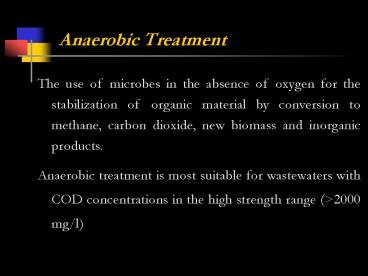Anaerobic Treatment - PowerPoint PPT Presentation
1 / 14
Title: Anaerobic Treatment
1
Anaerobic Treatment
Anaerobik Aritma Biyoteknolojisi
The use of microbes in the absence of oxygen for
the stabilization of organic material by
conversion to methane, carbon dioxide, new
biomass and inorganic products.
Anaerobic treatment is most suitable for
wastewaters with COD concentrations in the high
strength range (gt2000 mg/l)
2
Anaerobic Digestion Process
Anaerobik Aritma Biyoteknolojisi
3
Anaerobic Digestion Process
- Three Mechanisms Occurring
- Hydrolysis Process conversion of insoluble high
molecular compounds (lignin, carbohydrates, fats)
to lower molecular compounds - Acidogenesis Process conversion of soluble
lower molecular components of fatty acids, amino
acids and sugars (monosaccharides) to lower
molecular intermediate products (volatile acids,
alcohol, ammonia, H2 and CO2) - Methanogenesis Process conversion of volatile
acids intermediate products to final product of
methane and CO2
Anaerobik Aritma Biyoteknolojisi
4
Comparing Aerobic and Anaerobic Systems
Anaerobic Treatment
Aerobic Treatment
Anaerobik Aritma Biyoteknolojisi
- Methane is a useful end product. Thus, it is an
energy productive process.
- Requires an energy input.
- Low production of waste biological sludge (Y0,05
VSS/BOD5)
- The problem of excess sludge disposal.
- No energy requirements for aeration.
- Treatment rates are limited by oxygen transfer.
- The process can handle high loading rates.
- Due to low O2 transfer rate, limited BOD or COD
can be applied.
- Anaerobic sludge can be preserved unfed for
several months without any serious deterioration.
- It is difficult to preserve the active biomass.
- No offensive odor exists since the process by its
nature is totally closed
- Odor Problem.
- Low nutrient requirements.
- Nutrient addition.
5
Reactor Configurations
First Aplications
Anaerobik Aritma Biyoteknolojisi
- Anaerobic Contact Reactor
- SCHROEPFER (1955)
- Anaerobic Filter
- COULTER (1957)
- YOUNG McCARTY (1969)
- Anaerobic Sludge Blanket Reactor
- LETTINGA (1980)
- Hibrid Filter
- CHUNG CHOI (1993)
6
Disadvantages
Anaerobik Aritma Biyoteknolojisi
Anaerobic processes may also have disadvantages
the main disadvantage is the SLOW GROWTH of the
mathane forming bacteria. Slow growth rates
require a relatively long detention
time. Anaerobic bacteria are highly susceptible
to inhibition by a large number of compounds and
the process itself is vulnerable to exernal
influences such as temperature, pH, mixing.
7
System Requirements
Anaerobik Aritma Biyoteknolojisi
- This depends on
- Temperature
- pH
- Alkalinity
- Presence of Inhibitors (Toxicity)
8
Temperature
Anaerobik Aritma Biyoteknolojisi
- Temperature is one of major design and operation
parameters among other environmental factors. - Higher temperature, shorter digester retention
time - Depending temperature of wastewater discharge,
heating may be necessary. Otherwise provide
longer retention time (at larger reactor/capital
cost!)
9
Temperature
Anaerobik Aritma Biyoteknolojisi
- The metabolic activities of microorganisms at any
stage of anaerobic digestion is strongly
temperature depent. Three temperature ranges are
defined - As low as 80C
- Psychrophilic (below 200C)
- Mesophilic (30-400C)
- Thermophilic (50-600C)
10
Temperature
Anaerobik Aritma Biyoteknolojisi
- Optimum temperature is 350C for Mesophilic
systems and 550C for Thermophilic systems. - Temperature should be maintained at a constant
level !!! - Produced methane gas can be used for heating.
11
pH
Anaerobik Aritma Biyoteknolojisi
- Methane producing bacteria sensitive to pH.
Inhibited at low pH, less than 6.2. Volatile
acids accumulate further drop in pH. - Maintain operating pH near neutral, 6,5-7,5.
12
Alkalinity
Anaerobik Aritma Biyoteknolojisi
The anaerobic processes influence the alkalinity.
The acid step reduces the alkalinity and the
methane step increases it. The over all result is
a small reduction in alkalinity. Any decrease in
pH degree should be buffered by adittion of an
alkaline material. Alkalinity of 2500 mg/l
provides much buffer capacity when digestion is
proceeding satisfactorly, the alkalinity will
normally range from 1000-6000 mg/l
13
Presence of Inhibitors (Toxicity)
Effect on growth rate of bacteria by
inhibiting (declined). volatile acids
propionic acid limiting (gt10 mg/l)
ammonia from protein degradation. Free NH3
more toxic ( toxic if gt 150mg/l). pH to control.
At pH 7.2, mostly ammonium ions (toxic if
3000mg/l) metal ions from addition of base to
control pH. Careful not to exceed toxic levels.
No sudden increase and allow acclimatization
period, can tolerate moderately inhibitory for
some time. sulfides from protein
degradation. Only soluble sulfides effect.
Precipitate out by addition of iron. heavy
metals toxic at low concentration. Not too
much worry, precipitate out with sulfides i.e. no
longer soluble. Naturally occurring usually
sufficient.
Anaerobik Aritma Biyoteknolojisi
14
Anaerobik Aritma Biyoteknolojisi































